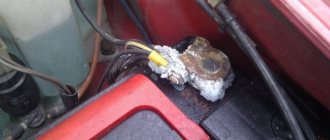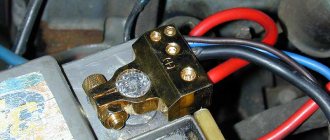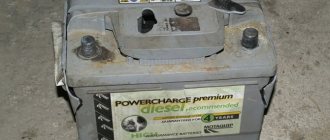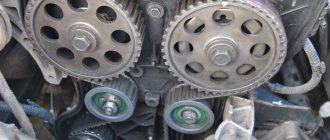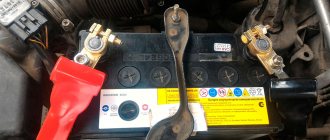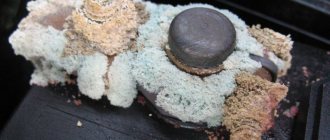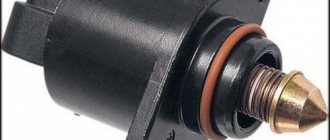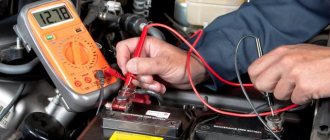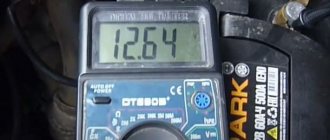If you use something correctly, it will last longer. Problems with new batteries are rare, especially if we are talking about a maintenance-free model. But sometimes it becomes necessary to remove the power source, for example, for recharging. The procedure is simple, but when connecting the battery back, it is important not to mix up the wires. In this article we will look at what happens if you mix up the battery terminals on a car.
If the battery is connected incorrectly, it may break and catch fire.
About battery terminal polarity
Batteries are produced with different characteristics, and the terminal locations also differ. A simple way to visually determine polarity:
- The battery is placed with the contacts facing you.
- With straight polarity, the “+” terminal will be on the left.
- With reverse “+” on the right.
Cars have different designs, which determine the principle of battery placement. In Asian cars (Hyundai, Kia, Daewoo, etc.) and VAZ models, the polarity is straight.
Straight polarity was invented back in the Soviet years, and on the Russian market it is usually designated as “1”. Reverse polarity is used in foreign cars (Ford and other "Americans"). In this case, the terminals can be placed not in the upper part of the housing, but on the sides.
Battery terminal polarity.
How to buy the right battery
When buying a battery in a store or at a car market, the car owner needs to select it according to the main parameters:
- sizes;
- polarity;
- containers;
- starting current.
If the battery is too large, it will not be possible to fix it on the battery platform, and you need to be aware that the plates of an unsecured battery will quickly fall off due to vibration. The polarity of the new battery must correspond to the type of car, and if the driver is not at all versed in cars, he must at least remember how the terminals of the old battery are located, or sketch, so as not to forget, the location of the terminal pins. It is also important to choose the same polarity as it was, so as not to get confused - if the battery is connected incorrectly, a short circuit occurs with unpleasant consequences for the car owner.
You should not buy a battery with a reduced capacity; for a standard passenger car without air conditioning and other additional electrical equipment, the battery must have a capacity of at least 55 Ampere-hours. If there are many consumers in the electrical circuit, you can purchase a 60 Ah battery.
When purchasing a new battery, you should try to purchase a battery with the maximum starting current. There will be no harm to the engine from such a battery, but the starter will be able to crank the engine in frosty weather without problems. It would also be a good idea to take a voltmeter (multimeter) with you and check the voltage at the battery terminals - for a normally charged battery it should be about 12.5 Volts.
We recommend: Procedure for draining antifreeze from the cooling system - where is the drain plug
What happens if you mix up the terminals?
If the driver mixed up the battery terminals and nothing happened, which rarely happens, you must immediately remove the battery. The consequences of incorrect connection are different, and the most harmless is replacing the fuses.
Closure
It is difficult not to notice a short circuit due to the abundant sparking. And even an inexperienced driver will immediately realize that something is wrong. Assuming the battery works with electricity, as it should, melting wires and smoke will tell you otherwise.
For a driver faced with a short circuit, the first thing to do is to immediately disconnect at least one terminal.
Ignition, fire
If you leave an incorrectly connected battery for 10 minutes, there is a high risk of fire.
The most critical scenario. Sparks flying in all directions from under the hood will not lead to anything good. And if you leave the battery for 10 minutes during polarity reversal, there is a high probability of fire. Small electrical wiring begins to melt at a current strength of 55 - 60 A, and so not far from its braiding ignites. And there are also flammable technical fluids in the engine compartment. On average, a passenger car burns out in just 10 minutes.
You need to act quickly in such situations. If the battery was charged from a charger, pull out the plug. If an ignition does occur, the source of ignition is immediately extinguished.
Battery power drop
The design of a car battery has plates: some with positive polarity, others with negative polarity. Each one holds a charge and, if the terminals are connected incorrectly, a polarity reversal will occur - the “minuses” will tend to become “pluses”, and vice versa.
Due to the polarity reversal, the plates will begin to deform. And, if at least one is destroyed, part of the battery power will be lost. As a result, the capacity level will decrease, which in severe winter may not even be enough to start the car. And if the plates fall out, you can safely look for a new power source.
Damage to the electronic control unit
ECU board.
It happens that the driver connects the terminals incorrectly, and at first nothing happens. That is, the fuses do not react at all, which also happens. In such a situation, the ECU board, an important electronic component, will suffer - it will burn out. The on-board computer board, which is also called the “brains,” does not tolerate voltage surges, and if it fails, you will not be able to operate the car.
Fuse burnout
In terms of subsequent restoration costs, this is the most optimistic scenario. Fuse blocks are needed to protect consumers from increased current values.
If the driver reacted quickly and reconnected the battery correctly, it is still necessary to check the functionality of the electrical equipment - less powerful fuses could have blown, taking the brunt of the blow. If this is the case, and the car starts, it will be enough to replace the failed elements.
Generator failure
This part of the car is protected from failure by a diode bridge (if there is one). Due to a short circuit, it burns out, while the battery producing the current remains in working condition.
Problems with the generator will be indicated by an icon in the form of a battery that lights up on the dashboard. If the diode bridge burns out, no current will flow to the battery, that is, the generator will not be able to charge it.
Generator failure indicator.
As a rule, the generator does not change on its own, as this is a labor-intensive process. Usually the car is taken to a service station.
Alarm failure
Let us immediately note that standard protective equipment will not deteriorate, but third-party alarm systems may fail. Typically, special triggers are added to such devices that work with a specific connection scheme. And polarity reversal can disable them.
To restore your car's protection, you will have to contact the technician who installed the alarm.
Partial melting of wires
Due to a short circuit caused by incorrect connection of the terminals, not only the wires going to the battery can melt. The insulation of all wiring where there is an increased load will suffer.
Insulation failures can cause some vehicle systems to not function as intended. Due to power losses in the circuit, fuel consumption will increase, the brightness of the headlights will decrease, etc.
How to fix a breakdown - the wires are insulated with special tape. But this is only in emergency cases, for example, when the problem occurs on the road, and there is no way to properly diagnose the car. So, melted wires should be replaced with new ones.
What are the consequences for a car owner when the polarity is reversed?
It is important to remember: the design of the car assumes the use of only batteries of a certain size and terminal location. It is possible to install a battery of similar capacity, but not the correct polarity, into the seat. But it will no longer be possible to connect it in standard mode. Because the wires simply won't reach.
It is no coincidence that such a difference between batteries is present: incorrect polarity will cause damage to the car’s electronics. The engine control unit may fail and a short circuit may occur. It is important to remember: not all electrical appliances fail when changing poles. But many will be damaged. Such situations should be avoided.
Moreover, in some cases, the holes in the terminals are even different. Usually the diameter of the positive one is slightly larger than the negative one. Therefore, it will be difficult to confuse them even by accident. Moreover, changing the poles can cause the starter to rotate in the other direction. Some engines may require major overhaul after this.
We recommend: Antifreeze: red, green, blue - what is the difference and which one is better to fill?
What happens if you mix up the terminals when charging the battery?
If you notice the error in time and take appropriate measures, the consequences will be avoided. Otherwise, there is a high probability that the charger will burn out. If the battery has been severely discharged, it may “reverse polarity,” that is, the terminal pins will change polarity.
To return the polarity to normal, you need to completely discharge the battery, but slowly, for example, leaving the headlights on, and then charge it, having already connected the polarity properly.
It is recommended to give preference to chargers with a fuse - it will protect against burnout. Complete chargers have such protection, but many Chinese models do not, and it is better not to risk the performance of the battery.
Is it easy to get confused with connecting terminals?
In order not to accidentally get confused when connecting the terminals to the batteries, the negative terminal was made thinner than the positive one. That is, it will be very difficult to put the negative one on the positive contact, and the positive one cannot be simply attached to the negative contact. In addition, next to each contact there will be symbols “+” and “-”. Sometimes they are also distinguished in red and black (blue).
If the designations have been erased and it is impossible to determine where the “plus” and “minus” are, then there is no need to guess. To avoid confusion with the connection, it is recommended to use a tester or multimeter to determine the polarity of the battery. Even a severely discharged battery will be able to provide sufficient voltage to perform such a diagnosis.
Poor indoor lighting or work in the dark can also result in battery polarity reversal. Therefore, even if it is not possible to organize normal lighting, when connecting the battery, you can turn on the cell phone and accurately determine the polarity.
Note! The positive terminal is always thicker than the negative terminal and is indicated by a “+” sign; sometimes there is also a red casing on the contact.
What happens if you mix up the terminals when lighting a cigarette?
The procedure for disconnecting the wires when lighting a cigarette.
If the wires are connected incorrectly, a short circuit will occur. And if they are of poor quality and thin, they will simply burn out. The higher the cross-section, the lower the likelihood of burnout, but the wires will start to heat up, and this will lead to other consequences.
“Plus” is connected first, then “minus”. After “lighting up”, the order of disconnecting the wires is as follows: first “minus”, then “plus”.
“Lighting up” is an extreme measure, as it loads the on-board network.
Having mixed up the battery terminals, the first thing you need to do is reset them, and then you can avoid more serious consequences. The price of a mistake can be the car itself, and the driver must remain vigilant.
Ways to determine polarity
You can determine this parameter for correct connection of wires by carefully inspecting the device. As mentioned above, each polarity has its own marking, as well as symbols near the terminals for connecting wires. The service book for the car, as well as the tips given above (the author of the video is the Nik86 auto-construction channel), will allow you to find out this parameter more accurately.
We recommend: How the DPKV works, its malfunctions and testing
If there are no marks or signs of polarity on the battery design, and accordingly, you do not know how to connect the wires, then you can try to conduct a test. You will need a multimeter, the probes of which must be connected to the terminals. If the voltage on the tester display is positive, this indicates that the probes were connected correctly (there are o and “-” on the probes themselves). If the diagnostics showed a negative voltage, then you connected the testing device incorrectly.
There are several other ways to determine:
- By color designation. Many modern batteries have color markings - in this case, the positive terminal is always marked in red. So it’s impossible to confuse the conclusions.
- By pin sizes. Experienced car enthusiasts know that the positive terminal is always larger than the negative terminal. This difference is typical for many modern batteries, and even as the device wears out, it remains. As you understand, using these methods to determine a parameter is much easier than using a multimeter.
Batteries manufactured in the USA simply do not have pins - instead, the device is equipped with recesses into which conductive contacts are mounted.
Partial melting of wires
Due to a short circuit caused by incorrect connection of the terminals, not only the wires going to the battery can melt. The insulation of all wiring where there is an increased load will suffer.
Insulation failures can cause some vehicle systems to not function as intended. Due to power losses in the circuit, fuel consumption will increase, the brightness of the headlights will decrease, etc.
How to fix a breakdown - the wires are insulated with special tape. But this is only in emergency cases, for example, when the problem occurs on the road, and there is no way to properly diagnose the car. So, melted wires should be replaced with new ones.
Find out more about the new Logan
- Maximum mileage of Logan engine
- Prices for services
- Wiring diagram - low beam Renault Logan
- Replacing antifreeze in Renault Logan: how to drain, how to replace Renault Logan coolant
- Auto electrics, electrics, diagrams, garage - Renault Logan electrical diagram
- Review from the owner of a Renault Logan 2022 (II Restyling): Stepway 1.6 MT (82 hp) | Auto RU
- How to learn to drive a car from scratch: step-by-step driving instructions for manual beginners
- Renault Logan 1.4 engine: service life, power, malfunctions
Damage to the electronic control unit
ECU board.
It happens that the driver connects the terminals incorrectly, and at first nothing happens. That is, the fuses do not react at all, which also happens. In such a situation, the ECU board, an important electronic component, will suffer - it will burn out. The on-board computer board, which is also called the “brains,” does not tolerate voltage surges, and if it fails, you will not be able to operate the car.
Currently reading: Renault Logan car wreckers in Chelyabinsk - phone numbers and addresses, reviews and ratings
Consequences for the battery
Of course, the battery itself may also be damaged. True, with different consequences, which will depend on the speed of your reaction and on the current state of the power source.
If you mix up the battery terminals, the current will flow to the plates not in the usual direction, but in the opposite direction. This process is called polarity reversal, when the positive plates temporarily become negative and vice versa. What's bad about it?
Such a situation cannot be called fatal, but if you let everything take its course, then such a situation initiates the process of shedding of the plus plates until they are destroyed. The sooner you reset the terminals, the better. If the battery is new, then a couple of minutes of polarity reversal may go unnoticed.
Ignition, fire
If you leave an incorrectly connected battery for 10 minutes, there is a high risk of fire.
The most critical scenario. Sparks flying in all directions from under the hood will not lead to anything good. And if you leave the battery for 10 minutes during polarity reversal, there is a high probability of fire. Small electrical wiring begins to melt at a current strength of 55 - 60 A, and so not far from its braiding ignites.
Currently reading: How to open your Renault Logan without a key? Tips from the pros - New Logan
You need to act quickly in such situations. If the battery was charged from a charger, pull out the plug. If an ignition does occur, the source of ignition is immediately extinguished.
Generator failure
This part of the car is protected from failure by a diode bridge (if there is one). Due to a short circuit, it burns out, while the battery producing the current remains in working condition.
Problems with the generator will be indicated by an icon in the form of a battery that lights up on the dashboard. If the diode bridge burns out, no current will flow to the battery, that is, the generator will not be able to charge it.
Generator failure indicator.
As a rule, the generator does not change on its own, as this is a labor-intensive process. Usually the car is taken to a service station.
What does direct and reverse mean?
Let's take a closer look at each type of battery:
- With straight polarity. This development is relevant mainly for domestic engineers. Its peculiarity is that the positive terminal “+” is located on the left side, and the negative terminal “-” is located on the right side of the top cover of the case.
- With reverse polarity. Such batteries are mainly used in European countries. The polarity is located as follows: minus “-” is on the left, and plus “+” is on the right.
To be fair, it is worth noting that not all cars from Europe have batteries with reverse polarity; often those models that are assembled in the CIS countries are equipped with direct polarity.
Many motorists carry out battery maintenance on their own, and one of the few problems that arise is determining the polarity. You can usually find out where the negative and positive terminals are by visual inspection. If that's not enough, no expensive tools or equipment will be required. You cannot operate the car unless you are completely sure that the battery is connected correctly. When it is impossible to carry out the check yourself, it is worth contacting specialists.
Closure
A situation where a driver has mixed up the battery terminals can have different consequences, but one name is a short circuit. It is impossible not to notice this: abundant sparking is the minimum that will make even an inattentive and not very smart driver panic and “turn on their brains.”
But even this phenomenon will be taken for granted (“this is electricity, it should spark!”), the wires will instantly begin to heat up, and this should definitely force the car owner to react - smoke coming from the wires cannot be called a normal phenomenon.
